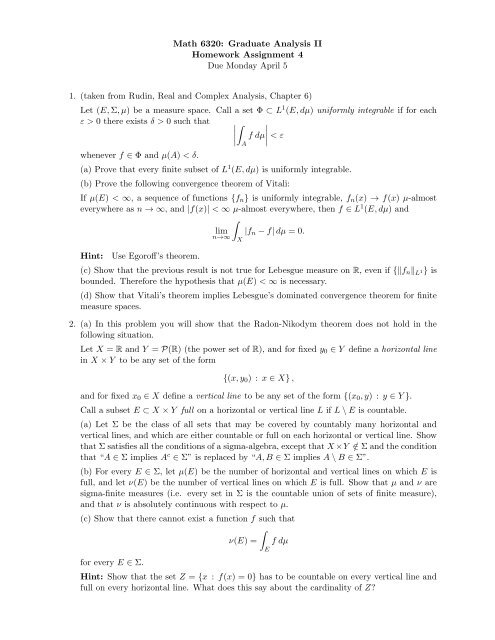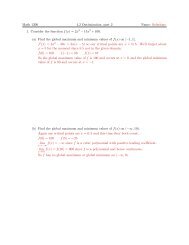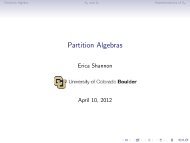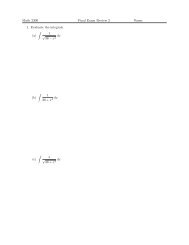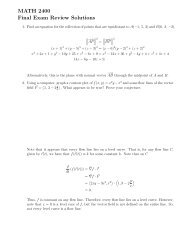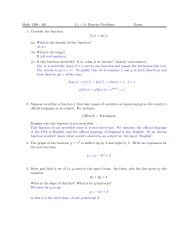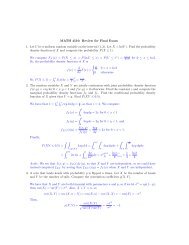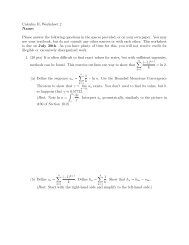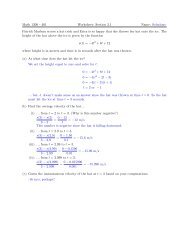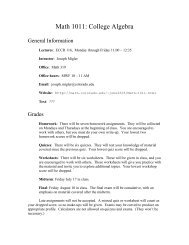Math 6320: Graduate Analysis II Homework Assignment 4 Due ...
Math 6320: Graduate Analysis II Homework Assignment 4 Due ...
Math 6320: Graduate Analysis II Homework Assignment 4 Due ...
Create successful ePaper yourself
Turn your PDF publications into a flip-book with our unique Google optimized e-Paper software.
<strong>Math</strong> <strong>6320</strong>: <strong>Graduate</strong> <strong>Analysis</strong> <strong>II</strong><strong>Homework</strong> <strong>Assignment</strong> 4<strong>Due</strong> Monday April 51. (taken from Rudin, Real and Complex <strong>Analysis</strong>, Chapter 6)Let (E, Σ, µ) be a measure space. Call a set Φ ⊂ L 1 (E, dµ) uniformly integrable if for eachε > 0 there exists δ > 0 such that ∣∫∣∣∣ f dµ∣ < εwhenever f ∈ Φ and µ(A) < δ.(a) Prove that every finite subset of L 1 (E, dµ) is uniformly integrable.(b) Prove the following convergence theorem of Vitali:AIf µ(E) < ∞, a sequence of functions {f n } is uniformly integrable, f n (x) → f(x) µ-almosteverywhere as n → ∞, and |f(x)| < ∞ µ-almost everywhere, then f ∈ L 1 (E, dµ) and∫|f n − f| dµ = 0.Hint:Use Egoroff’s theorem.limn→∞X(c) Show that the previous result is not true for Lebesgue measure on R, even if {‖f n ‖ L 1} isbounded. Therefore the hypothesis that µ(E) < ∞ is necessary.(d) Show that Vitali’s theorem implies Lebesgue’s dominated convergence theorem for finitemeasure spaces.2. (a) In this problem you will show that the Radon-Nikodym theorem does not hold in thefollowing situation.Let X = R and Y = P(R) (the power set of R), and for fixed y 0 ∈ Y define a horizontal linein X × Y to be any set of the form{(x, y 0 ) : x ∈ X} ,and for fixed x 0 ∈ X define a vertical line to be any set of the form {(x 0 , y) : y ∈ Y }.Call a subset E ⊂ X × Y full on a horizontal or vertical line L if L \ E is countable.(a) Let Σ be the class of all sets that may be covered by countably many horizontal andvertical lines, and which are either countable or full on each horizontal or vertical line. Showthat Σ satisfies all the conditions of a sigma-algebra, except that X ×Y /∈ Σ and the conditionthat “A ∈ Σ implies A c ∈ Σ” is replaced by “A, B ∈ Σ implies A \ B ∈ Σ”.(b) For every E ∈ Σ, let µ(E) be the number of horizontal and vertical lines on which E isfull, and let ν(E) be the number of vertical lines on which E is full. Show that µ and ν aresigma-finite measures (i.e. every set in Σ is the countable union of sets of finite measure),and that ν is absolutely continuous with respect to µ.(c) Show that there cannot exist a function f such that∫ν(E) = f dµfor every E ∈ Σ.Hint: Show that the set Z = {x : f(x) = 0} has to be countable on every vertical line andfull on every horizontal line. What does this say about the cardinality of Z?E
3. Use Fubini’s theorem to show that if f ∈ L 1 [0, 1] (with respect to Lebesgue measure) anda > 0, then the integralF a (x) =∫ x0(x − t) a−1 f(t) dtexists for almost every x ∈ [0, 1], and that F a ∈ L 1 [0, 1].4. Problems 24, 26, 27 from Wheeden and Zygmund Chapter 10.


